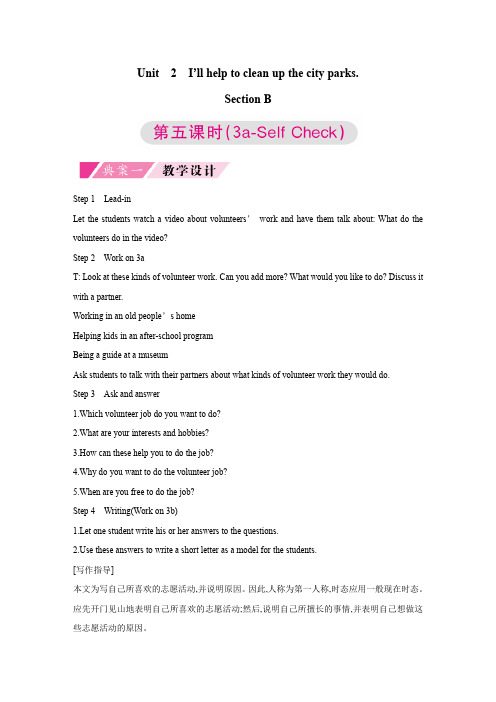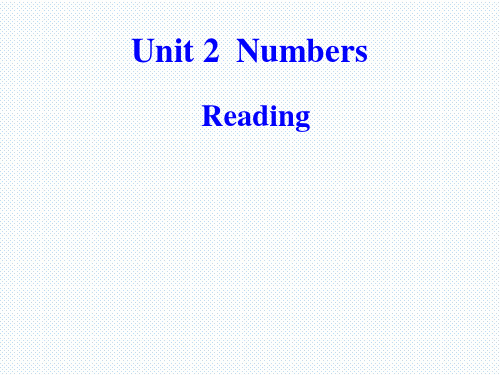英语人教版八年级下册Unit2 教学设计
- 格式:doc
- 大小:31.00 KB
- 文档页数:3

Unit2I’ll help to clean up the city parks.Section BStep 1Lead-inLet the students watch a video about volunteers’work and have them talk about: What do the volunteers do in the video?Step 2Work on 3aT: Look at these kinds of volunteer work. Can you add more? What would you like to do? Discuss it with a partner.Working in an old people’s homeHelping kids in an after-school programBeing a guide at a museumAsk students to talk with their partners about what kinds of volunteer work they would do.Step 3Ask and answer1.Which volunteer job do you want to do?2.What are your interests and hobbies?3.How can these help you to do the job?4.Why do you want to do the volunteer job?5.When are you free to do the job?Step 4Writing(Work on 3b)1.Let one student write his or her answers to the questions.e these answers to write a short letter as a model for the students.[写作指导]本文为写自己所喜欢的志愿活动,并说明原因。

人教版八年级英语下册大单元教学设计优秀案例全文共3篇示例,供读者参考篇1Teaching Design of the Unit "Life in the Future"Ⅰ. Teaching Aims:1. Knowledge goals: Students can grasp and use the target language in daily communication, and master the vocabulary and grammar points related to the topic of life in the future.2. Ability goals: Students can improve their listening, speaking, reading, and writing skills by carrying out various activities in different forms.3. Emotional and attitudinal goals: Students can broaden their horizons, cultivate their imagination, and develop a positive attitude towards the future.Ⅱ. Key Points and Difficult Points:1. Key points: Key vocabulary and grammar points related to life in the future.2. Difficult points: The use of verb tenses to talk about future events, as well as the application of vocabulary and grammar points in practical communication.Ⅲ. Teaching Content:1. New words and phrases related to the topic of life in the future.2. Grammar points: Future tense, comparison of adjectives, modal verbs (could, might, may), etc.3. Reading and listening materials about life in the future.Ⅳ. Teaching Methods:1. Task-based learning approach: Organize various tasks and activities to stimulate students' interest and motivation in learning English.2. Communicative approach: Encourage students to participate in pair work, group work, and class discussions to practice their English speaking skills.3. Multimedia teaching: Use multimedia resources such as videos, pictures, and online resources to create a vivid and engaging learning environment.Ⅴ. Teac hing Procedures:1. Lead-in: Show students a video or pictures related to life in the future to arouse their interest and activate their prior knowledge.2. Presentation: Introduce new vocabulary and grammar points through real-life examples and explain their usage.3. Practice: Conduct various activities such as role-plays, conversations, and games to help students consolidate their knowledge and improve their skills.4. Production: Ask students to write a short paragraph or give a presentation on their vision of life in the future using the target language.5. Evaluation: Assess students' performance through quizzes, tests, and peer evaluations to provide feedback for further improvement.6. Homework: Assign tasks such as writing a diary entry about a day in the future or researching a topic related to life in the future.Ⅵ. Teaching Materials and Resources:1. Textbook: Use the textbook as the main reference for teaching materials and exercises.2. Audio and video materials: Play audio recordings and videos to enhance students' listening and speaking skills.3. Online resources: Use online platforms and websites to access additional materials and practice exercises.4. Visual aids: Use flashcards, charts, and posters to facilitate students' understanding and retention of new information.Ⅶ. Teaching Strategies:1. Differentiated instruction: Provide support and challenge for students of different levels by adjusting tasks and activities accordingly.2. Collaborative learning: Encourage students to work together in pairs or groups to foster teamwork and communication skills.3. Feedback and reflection: Give constructive feedback to students on their performance and encourage self-reflection for continuous improvement.4. Cultural awareness: Integrate cultural elements into the lesson to help students appreciate the diversity of perspectives on life in the future.Ⅷ. Conclusion:Through this comprehensive and innovative teaching design, students will have the opportunity to explore and envision life in the future while improving their English language skills. By engaging in various activities and tasks, students will enhance their communication abilities and develop a positive attitude towards the future. This teaching design aims to create a dynamic and interactive learning environment that motivates students to actively participate in the learning process and achieve academic success.篇2Unit 1: HealthTeaching Goals:1. Students will be able to talk about health habits and give advice.2. Students will be able to discuss different types of illnesses and symptoms.3. Students will be able to understand and use vocabulary related to health and wellness.Key Vocabulary:- illness (n.): a disease or sickness- symptom (n.): a sign that indicates the presence of a disease- fever (n.): a high body temperature- cough (n.): expel air from the lungs with a sudden sharp sound- headache (n.): a continuous pain in the head- sore throat (n.): pain or irritation in the throat- stomachache (n.): pain in the stomach or abdomen- healthy (adj.): in good physical conditionLesson 1: Talking about Health Habits1. Warm-up: Discuss with students what they do to stay healthy. Encourage them to share their health habits with the class.2. Vocabulary: Introduce key vocabulary related to health habits, such as exercise, balanced diet, and enough sleep. Have students practice using the vocabulary in sentences.3. Dialogue Practice: Have students practice a dialogue where they talk about their health habits with a partner.Encourage them to ask follow-up questions to gather more information.4. Role-Play: Divide students into pairs and have themrole-play a scenario where one student gives advice to the other about staying healthy.Lesson 2: Discussing Illnesses and Symptoms1. Vocabulary Review: Review key vocabulary related to illnesses and symptoms. Have students match the terms with their definitions.2. Listening Comprehension: Play a recording of different people describing their symptoms. Have students listen and identify the illnesses mentioned.3. Group Discussion: Divide students into small groups and have them discuss common illnesses and their symptoms. Encourage them to share personal experiences or stories.4. Presentation: Ask each group to choose an illness to present to the class. They should describe the symptoms, causes, and treatments for the illness.Lesson 3: Vocabulary and Grammar Practice1. Vocabulary Games: Play games like charades or Pictionary using health-related vocabulary. This will help reinforce the vocabulary and make learning fun.2. Grammar Focus: Teach students how to give advice using modal verbs like should, shouldn't, must, and mustn't. Have students practice giving advice in different scenarios.3. Writing Exercise: Ask students to write a short paragraph giving advice on how to stay healthy. They should include reasons and examples to support their advice.4. Review: Have a review session where students summarize what they have learned about health habits, illnesses, and symptoms.Assessment:- Quizzes on vocabulary and grammar- Role-plays and dialogues- Written assignments on health habits and illnessesOverall, this unit is designed to engage students in discussions about health, wellness, and self-care. The various activities and exercises will help students develop their communication skills and vocabulary related to health. By theend of the unit, students should be able to talk about health habits, discuss illnesses and symptoms, and give advice on maintaining good health.篇3Teaching Design of Unit 4 in People's Education Edition 8th Grade English TextbookI. Basic Information1. Unit: Unit 42. Grade: 8th Grade3. Textbook: People's Education Edition4. Duration: 4 weeksII. Teaching Objectives1. To enable students to master the vocabulary and grammar points in Unit 4.2. To develop students' reading and listening skills.3. To enhance students' ability to express ideas coherently in English.4. To cultivate students' interest in learning English.III. Teaching ProceduresWeek 1: Introduction to Unit 41. Introduce the theme of Unit 4: Health and Fitness.2. Present the new vocabulary related to health and fitness. Have students practice pronunciation and spelling.3. Play a listening comprehension game to introduce the main ideas of the unit.4. Assign homework: Read the passage "How to Keep Fit" and answer comprehension questions.Week 2: Reading Comprehension1. Review the vocabulary words learned in the previous week.2. Read and analyze the passage "How to Keep Fit" as a class. Discuss main ideas, key points, and answer comprehension questions.3. Pair students up to discuss the benefits of keeping fit and share their personal experiences.4. Assign homework: Write a short paragraph about their daily exercise routine.Week 3: Grammar Focus1. Introduce and explain the grammar points in Unit 4: Comparatives and Superlatives.2. Practice using comparatives and superlatives in sentences and conversations.3. Play a grammar game to reinforce understanding.4. Assign homework: Complete the grammar exercises in the workbook.Week 4: Speaking and Listening1. Have students prepare a short presentation on ahealth-related topic of their choice.2. Organize a group discussion on the importance of a healthy lifestyle.3. Watch a video or listen to a podcast about famous athletes and their fitness routines. Discuss as a class.4. Summarize the key points of Unit 4 and administer a quiz to assess understanding.IV. Evaluation and Assessment1. Class participation and engagement throughout the unit.2. Homework completion and quality.3. Performance on quizzes and tests.4. Improvement in reading, speaking, and listening skills.In conclusion, this teaching design for Unit 4 in the 8th Grade English textbook of People's Education Edition aims to create a dynamic and engaging learning environment for students to improve their English skills while learning about health and fitness. By incorporating various activities and exercises, students will be able to achieve the learning objectives and develop a deeper understanding of the English language.。



Unit 2 I’ll help to clean up the city parksSection B 2a-2e 教学设计教学分析本节课是八年级下册第2单元Section B2a-2e 阅读板块的教学内容。
该部分阅读材料是Ben Smith写给Miss Li 一封感谢信。
Ben Smith是一名残疾人,手脚都不能正常活动。
他的一位朋友帮他与“动物助手”组织联系,试图找到一条狗作为助手。
经过六个月的训练,他把狗助手Lucky带回了家。
Lucky很聪明,能听懂Ben Smith的命令,给了主人Ben Smith 很多帮助和快乐。
这一切都要感谢Miss Li , 她捐钱给“动物助手”组织,帮助Ben Smith得到Lucky,改变了生活。
阅读文本突出了本单元的核心话题Volunteering and Charity. 对于文本内容的人文内涵,教师要予以深刻挖掘,以期达到英语课程工具性和人文性的统一。
对于本篇阅读材料,教师要引导学生通过获取狗助手给主人带来的喜悦和生活的改变等信息,深刻理解Miss Li对Ben Smith的帮助与友爱,从而唤起学生对残疾人的关爱意识,培养学生对社会、对他人的爱心。
学情分析书信是学生比较熟悉的一种文体形式。
学生在七年级已经接触过英文书信,而且英文书信和汉语书信在格式上有很大相似之处。
因此,学生掌握英文书信并不难。
教师要带领学生回顾英文书信的格式,激活并强化学生的形式图式,为阅读文本做好准备。
此过程中,学生需要弄清楚阅读文本是Ben Smith写给Miss Li 的一封信,这是正确理解文本信息、了解作者写作意图的前提。
整体设计教学目标认知与技能:1.在语境中学会如下单词:blind, deaf, disabled, letter, difficulty, normal, kindness.2.运用正确的阅读策略阅读文本,理解其内容明白作者的写作意图。
3.领悟猜测词义的方法并运用这一阅读策略更好地理解文本。

Unit2What’sthematter?教案教学设计(新课标版英语八年级)Unit 2 What’s the matter?Section A一、教师寄语Reading is to the mind what exercise is to the body. 读书养心,锻炼健身。
二、学习目标知识目标:Words: matter; have; cold; stomachache; sore; back; arm; ear; eye; foot; hand; head; leg; mouth; neck; nose; stomach; tooth; throat; toothache; fever; rest; honey; dentist; should; headache; shouldn’tPhrases: have a cold have a sore throat have a fever see a dentistSentences:1. What’s the matter? I have a cold.2. I have a headache/stomachache/toothache/sore back/sore throat.3. You should go to bed/drink some water.能力目标: Enable the students to talk about health problems and give advice with the language points.情感目标: Help the students learn how to talk about health problems and give advice on that with the language points.三、教学重、难点Talk about your health.and give advice.四、学习过程1预习导学或自测Ⅰ.Students look at the pictures on the blackboard and learnthe new words about the parts of the body.1. b______2. n_____3. he_____4. ha_____5. ea_____6. ey_____7. f______ 8. m_____ 9. ne_____10. a______ 11. s_______ 12. l_____2.自主学习1.看医生/牙医2.感冒3.患牙痛4.患头痛5.发烧6.躺下休息7.喝大量水 8.喝热蜂蜜茶9.有压力 10.保持健康3.合作探究 .完成表格后对话。
Unit 2 I'll help to clean up the city parks.Section A 3a-3c教学设计一、教学目标:1. 语言知识目标:1) 学习掌握下列词汇:several, feeling, satisfaction, joy, owner, journey2)阅读短文,能按要求找到相应的信息。
3)通过阅读提高学生们的阅读能力。
4) 了解世界各地的学生们都进行哪些志愿活动。
2. 情感态度价值观目标:使学生在谈论如何为别人提供帮助的对话中能意识到尽己所能,帮助他人,乐于奉献是一种良好的品德,培养学生为他人着想,热爱公益事业,乐于助人的优良品质。
二、教学重难点:1. 教学重点:1) 掌握本部分出现的生词和词组,达到熟练运用的目标。
2) 阅读短文,获得相关的信息。
通过阅读练习,来提高阅读能力。
2. 教学难点:1) 阅读短文,获得相关的信息的能力。
2) 理解并运用所学的词汇及表达方式。
三、教学过程Step1: Free talk(1) Do you want to be a volunteer?(2) What can you do as a volunteer?Step 2: Prediction(1) Where is the boy in the first picture? What’s he doing?(2) Where are the girls in the second picture? What are they doing?(3) Do they work for money?Step 3: SkimmingRead the passage quickly and fill in the blanks. Students Who Volunteer:Mario works in:…an animal hospitalLoves: animalsMary works in: an after-school reading programLoves: readingStep 4:ScanningTask1: Read Para.2 and answer.What does Mario volunteer to do?He volunteers at an animal hospital to care for animals. Task2: Read Para.2 and fill in the chart.Task3: Read Para.3 and answerWhat does Mary volunteer to do?She works at an after-school reading program to help kids to readTask4: Read Para.3 and fill in the chart.Task5: Looking & Thinking观察表格中蓝色字体的动词短语及相应的横线上所填的单词,可以看出,to后均用的动词的______形式,这种_________________即为动词不定式的基本形式。